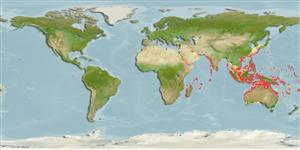Stephanometra indica (Smith, 1876)
| Native range | All suitable habitat | Point map | Year 2050 |

|
| This map was computer-generated and has not yet been reviewed. |
| Stephanometra indica AquaMaps Data sources: GBIF OBIS |
Mandar um arquivo com seu (sua) Fotos
Imagem do Google |
No photo available for this species.No drawings available for Mariametridae.
Imagem do Google |
No photo available for this species.
Classification / Names Common names | Synonyms | CoL | ITIS | WoRMS
| Comatulida | Mariametridae
Environment: milieu / climate zone / depth range / distribution range Ecologia
; intervalo de profundidade 0 - 73 m (Ref. 81020). Tropical
Distribuição Países | Áreas FAO | Ecossistemas | Ocorrências | Introduções
Indo-West Pacific.
Length at first maturity / Tamanho / Peso / Idade
Maturity: Lm ? range ? - ? cm
Occurs in tidepools (Ref. 101028). Subtidal on rocky outcrops at daylight (Ref. 102838). It is usually cryptic under rubble and at the reef during the day (Also Ref. 129602); it gets active at dusk, crawling to exposed perches and spreading its arms in a biplanar posture (Ref. 101028). Also found under dead and living corals (Refs. 100368, 129602). Suspension feeder (Ref. 68823).
Life cycle and mating behavior Maturidade | Reprodução | Desova | Ovos | Fecundidade | Larvas
Members of the class Crinoidea are gonochoric. During spawning, the pinnule walls rupture and the eggs and sperms are shed into the seawater. Life cycle: Embryos elongate into free-swimming larvae (doliolaria) which later sink to the bottom where they metamorphose into stalked sessile crinoid.
Referência principal
Referências | Coordenador | Colaboradores
Putchakarn, S. and P. Sonchaeng. 2004. (Ref. 2534)
Status na Lista Vermelha da IUCN (Ref. 130435)
Status no CITES (Ref. 108899)
Not Evaluated
CMS (Ref. 116361)
Not Evaluated
Perigo para os humanos
Harmless
Uso pelos humanos
| FishSource |
Ferramentas
Mais informação
Idade/Tamanho
Crescimento
Comprimento-peso
Comprimento-comprimento
Morfologia
Larvas
Abundância
Crescimento
Comprimento-peso
Comprimento-comprimento
Morfologia
Larvas
Abundância
Fontes da internet
BHL | BOLD Systems | CISTI | DiscoverLife | FAO(Publication : search) | Fishipedia | GenBank (genoma, nucleotídeo) | GloBI | Gomexsi | Google Books | Google Scholar | Google | PubMed | Árvore da vida | Wikipedia (Ir para, procura) | Registro zoológico
Estimates based on models
Preferred temperature
(Ref. 115969): 24.4 - 28.9, mean 27.7 (based on 880 cells).


